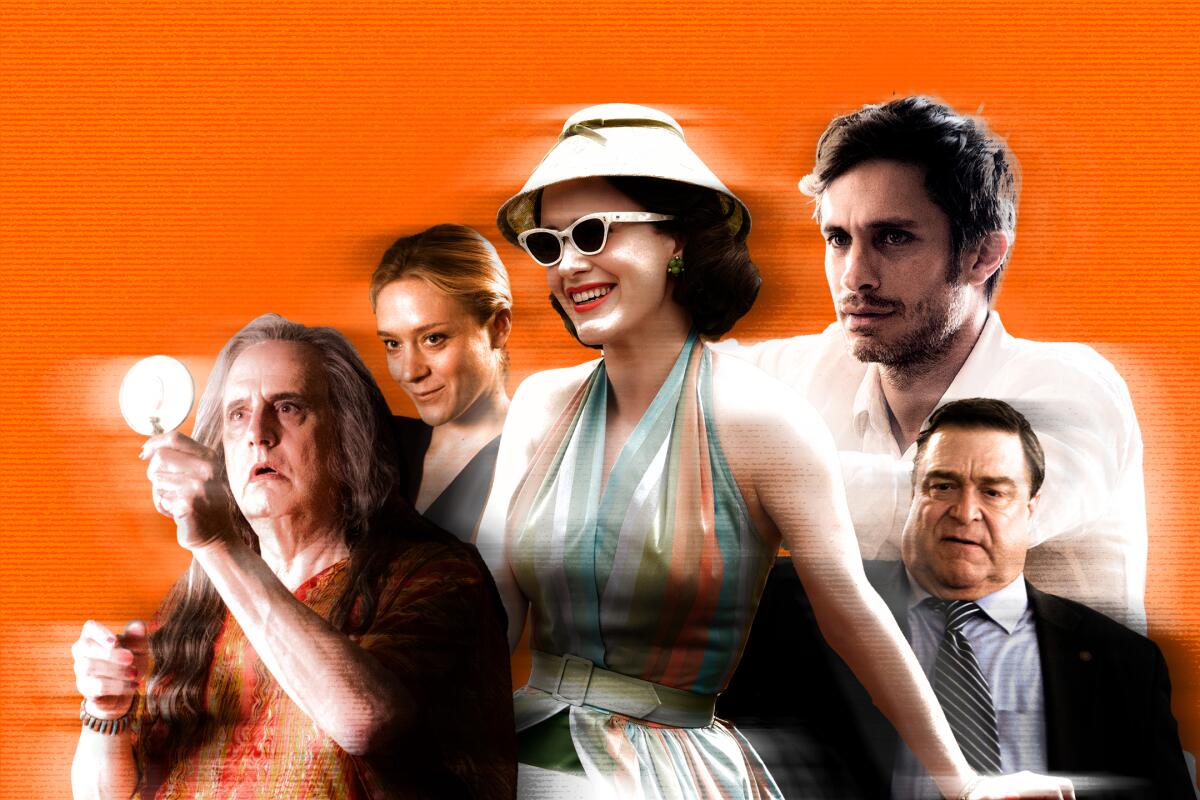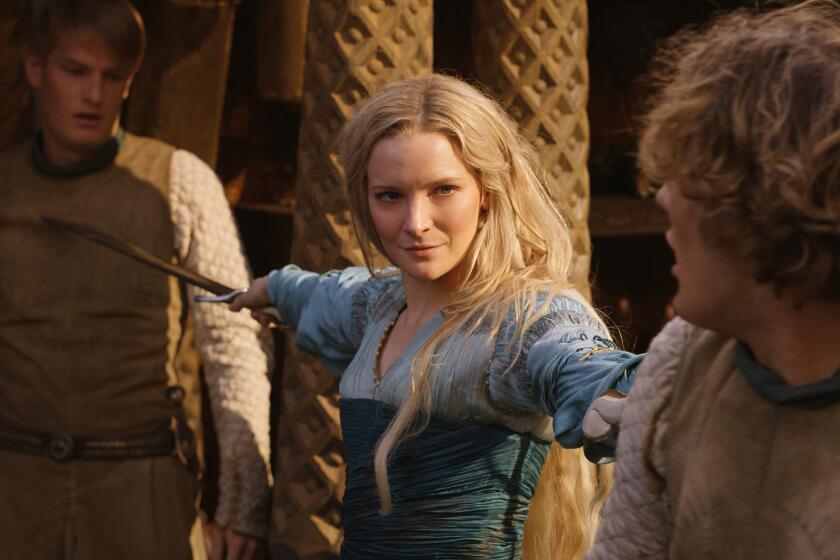Commentary: 10 years ago, Amazon tried to reinvent TV pilots. Its failure foretold our streaming future

- Share via
In 2013, Amazon’s fledgling streaming service, Prime Video, had a new form of competition to confront. With Netflix’s international expansion already proceeding at a rapid pace — the platform had that year launched buzzy original series “House of Cards” and “Orange Is the New Black” — streaming entered the realm of “prestige TV” formerly dominated by premium and basic cable. It was no longer just a new technology: It had suddenly become the way for newcomers to challenge media companies that had dominated the industry for a century. (Full disclosure: In addition to my work as a freelance entertainment journalist, I am also a part-time contractor for one of those companies, Paramount Pictures.)
Enter Amazon’s Pilot Season program. The company’s first foray into original content allowed anyone to watch TV pilots and provide feedback on which shows they wanted to see as full seasons. Through its ownership of the film and TV database IMDb, Amazon had identified a legion of dedicated fans they could draw from to help make their green-lighting decisions.
“We had an opportunity to get feedback,” said former Amazon Video and Amazon Studios chief Roy Price, “sort of in the way networks traditionally had by making pilots, except on a much larger scale because we were doing it in public.”
The Wild West of streaming’s early days promised the next major innovation in entertainment. Experimentation reigned. The need to create a catalog of new and familiar content to keep subscribers coming back month after month sparked an explosive proliferation of series — finally peaking with a record 599 original shows in 2022 — and, by extension, an openness to pioneering topics, tones and forms.
The very structure of televisual storytelling changed too. Instead of 22 episodes spread out from late September to early May, eight-, 10-, or 13-episode seasons could be made available all at once and be almost immediately binged by consumers. At least in theory, removing the pressure of time slots meant episodes themselves could vary wildly in length, and the absence of ads in those episodes meant act breaks could come in unexpected places, or not at all. Pilot Season was a part of this broader sense of possibility, built on the belief that streaming could bring viewers into the development process like never before.
On board, according to Price, was Amazon’s executive suite, including Chief Executive Jeff Bezos. Pilot Season, integrating the streaming revolution with the longstanding tradition of the focus group, was a perfect fit for a company whose “leadership principles” include “customer obsession.”
Amid a writers’ strike largely about the power of platforms, we take a snapshot of the streaming pecking order, from Netflix to (formerly HBO) Max.
If sheer breadth is what guided the first Pilot Season lineup — which featured 14 titles, including the satirical “Onion News Network,” political comedy “Alpha House” and a television adaptation of “Zombieland” from original film writers Rhett Reese and Paul Wernick — the following year’s crop refined Amazon’s vision. Though it contained fewer titles overall, the 2014 class featured “Transparent,” “Bosch” and “Mozart in the Jungle,” all of which ran for multiple seasons and brought commercial and critical acclaim to the Prime Video brand.
“We had 20 times more freedom than I’ve ever had before,” said indie film director Whit Stillman, whose pilot “The Cosmopolitans” premiered through Pilot Season in 2014. Streaming was offered as an alternative to the traditional TV business model, which had remained largely unchanged for decades. The streamer could also act as the production company and distributor, eliminating the need to spend months or years arranging financing.
Stillman was personally contacted by Price and Amazon Studios’ then-head of comedy programming Joe Lewis to write “The Cosmopolitans” because Price wanted a Paris-set series on the service. The pilot — starring Chloë Sevigny and Adam Brody — premiered to generally positive reviews and Stillman was commissioned to write scripts for the rest of the season before receiving an official greenlight. Amazon also continued to pay the actors’ options for a period of time after the pilot aired while Stillman worked on other projects, in order to leave the door open to picking up the show. (Amazon MGM Studios told The Times that paying actors’ options was not common practice among Pilot Season projects, however.)
Another benefit of the Pilot Season initiative, and of streaming more broadly, was that streamers were not beholden to advertisers — and so provided a direct line to the audience. “I had more creative freedom and more flexibility to tell riskier, edgier stories,” said Diarra Kilpatrick, whose “The Climb” was one of the last shows to premiere through the program in 2017. She had a competing offer from a traditional broadcast network but the latitude Amazon offered made it a more enticing outlet. “As a creator, you always want the work to be seen,” Kilpatrick said. “I want to entertain people, not executives.”
The measurement of consumer engagement wasn’t just PR, either, according to Price, with polarized responses being the most valued: “Let’s say rating things from 1 to 10, a lot of 10s and a lot of 1s can actually be OK. A 5 is the same as 1. Neither of those people are going to watch the show.” Memos that recapped the results of each Pilot Season cycle were considered alongside other factors to help make green-lighting decisions, he said.
But while Amazon continued to put out two cycles of Pilot Season every year, the program was not facilitating the level of “customer obsession” needed to compete in a rapidly innovating market. Netflix broke the business of TV by eliminating the use of pilots and ordering full seasons for all of its series. The delay created by Pilot Season put Amazon at a competitive disadvantage, frustrating customers who wanted more of the favorites they’d just voted for and limiting the company’s ability to scale up its original programming slate, according to Amazon MGM Studios.
A decade after Netflix disrupted the industry with ‘House of Cards,’ Peak TV is in retreat, and in its place is a new era of discontent.
“The tradition was, ‘We’ll do a focus group, run a pilot, get feedback,’” said Rahul Telang, co-author of the book “Streaming, Sharing, Stealing: Big Data and the Future of Entertainment.” “And Netflix didn’t do that. They had [detailed] microdata,” including how long a viewer watched an episode or which actors and directors viewers watched the most.
At times, creators of Pilot Season projects took up the task of advocating for their own series. For instance, Stillman partnered with a publicist and did interviews alongside Sevigny to promote “The Cosmopolitans” as if it were a soon-to-premiere movie. Indeed, though Pilot Season was promoted on the Amazon homepage during the pilot period, Amazon MGM Studios said no advertising campaigns were run on the pilots — because the program was designed for existing customers, not attracting new ones. “Because the show wasn’t technically green-lit, they’re not going to spend a ton on marketing,” Kilpatrick said.
The green-lighting of series outside of Pilot Season began to signal the end of the program. Shows like “The Boys” and “Invincible” were announced without ordering pilots. “By the last nine to 12 months [of Pilot Season], the whole thing was done,” according to Price. The program, which fostered long-term relationships between Amazon and creators like Joey Soloway (“Transparent,” “I Love Dick”) and Will Graham (“Mozart in the Jungle,” “A League of Their Own,” “Daisy Jones and the Six”), was soon accompanied by the sort of newsmaking deals with high-profile directors like Woody Allen and David O. Russell that have become trademarks of the streaming era — deals that closed without any public input.
Indeed, the Pilot Season brand that first attracted critics — “offbeat,” said Price; “indie,” per Kilpatrick — increasingly seemed to come up against the economic realities that have long defined Hollywood entertainment. Creative freedom was not necessarily going to win Amazon the streaming wars.
While Pilot Season was about encouraging viewer participation, the streaming industry became more entrenched in secrecy than traditional networks ever operated. Led by Netflix’s data-driven green-lighting approach, the business of TV became beholden to algorithms and hidden metrics — decision-making so opaque that the availability of streaming data to those making the shows became a central part of the recent writers’ and actors’ strikes.
Then, in 2017, Pilot Season came to a swift and ignominious end. Price resigned after “The Man in the High Castle” executive producer Isa Hackett accused him of sexual harassment. His successor, Jennifer Salke, installed a new team at the helm of series development. And the final crop of Pilot Season shows were all canceled within a month of airing.
The Prime Video series, nearing 100 million viewers for its first season, exemplifies the evolving nature of the hit TV show in the age of streaming.
When Salke officially announced the end of Pilot Season in 2018, she described Amazon’s pivot as an attempt to prioritize its “own testing barometers and some audience-driven data to make decisions” — in other words, bringing the decision-making back behind closed doors after a brief five-year window out in the (relative) open. In turn, the company told The Times, its programming now reflects a more comprehensive understanding of its entire customer base, rather than just Pilot Season participants.
For his part, Stillman sees the decision as an abandonment of the original vision for Prime Video in favor of a new flavor of the month: IP, or intellectual property. “I think Jeff Bezos had ‘Game of Thrones’ envy,” said Stillman. “He wanted to change the regime.” (Amazon MGM Studios denied Stillman’s claim, saying the company’s focus on IP came after the end of pilot season. It was in 2017, the year of the final Pilot Season, that Amazon purchased the rights to produce “The Lord of the Rings” prequel series “The Rings of Power.”)
When “The Marvelous Mrs. Maisel” concluded earlier this year, becoming the last of the series that came out of the program to go off the air, Pilot Season officially became part of the history of streaming, and no longer part of its present. It now registers as a relic of promise — of transparency for viewers, freedom for creators, great television for all — that has since been lost. Though new contracts for writers and actors may improve the situation, viewership data, to say nothing of algorithmic details, remains hard to pin down. Ad-supported streaming, coming to Prime Video on Jan. 29, is in the ascendance across the industry. The onetime explosion of content, and the experimentation it propelled, first slowed, and may now reverse. TV shows and streaming movies can once again be canceled shortly after premiering (and sometimes even before), then erased entirely. A decade after Pilot Season signaled the start of a streaming revolution, viewers are no more able to engage in programming decisions than they ever were, by voting with their feet.
The pilots that premiered during Pilot Season still have web pages, though the episodes are no longer able to be viewed. Amazon’s main web page for the program has also been wiped. If there’s any lesson to be taken from the first decade-plus of streaming, it might be the one communicated by this minuscule detail: If something doesn’t work at scale, it can all too easily disappear entirely.
More to Read
The complete guide to home viewing
Get Screen Gab for everything about the TV shows and streaming movies everyone’s talking about.
You may occasionally receive promotional content from the Los Angeles Times.









